STANDARD DESCRIPTION
GENERAL APPEARANCE, BEHAVIOUR AND CHARACTER
The Pumi is a special rare breed in Group I. It is undoubtedly a sheepdog, as this is the breed’s ancient fundamental function, clearly evidenced by its still existent herding instinct. Simultaneously, it is also a Terrier, as proved by its appearance, habits and Terrier-like temper. The scientific Latin name of the pumi adequately expresses these features: Canis familiaris ovilis villosus terrarius Raitsitsi (Anghi, 1935).
This name establishes the most important characteristics of this breed: — ovilis — hearding capacity,
— villosus — bushy hair,
— terrarious — Terrier-like character.
Thus the pumi is — a Raitsits-type herding dog with bushy hair and Terrier character traits. This breed is predominated by its Terrier features both in external (appearance) and in internal (character) features.
External Terrier traits (appearance):
— elongated foreface;
— unnoticeable stopline,
— upright ears bending at end,
— chest is deep rather than barreled,
— breast is deep rather than wide,
— medium long, tufty hair suitable for trimming.
Internal terrier characteristics:
— vivid, lively temper,
— extremely bold,
— abrasive nature,
— noisy expression,
— excellent smell,
— passion for search,
— hunting instinct.
Most important features inherited from the Puli:
— unparalleled intelligence,
— smartness,
— excellent learning skills,
— excellent adaptability,
— herding instinct.
HEAD
The most attractive and at the same time the funniest body part of the Pumi is his head. His farcical pom-pom-ears look, the adorable yet naughty facial expression immediately arouses a sense of attraction in the observer.
The terrier character in the Pumi is also best reflected by the head. The end of the nose is slightly elongated and slightly tapering towards the tip. The cheeks are muscled, the line of teeth is not narrow, the teeth are large and very strong. The nose of the Pumi is not pointed.
The foreface accounts for about 45 % o the head, almost half. The dog is considered pretty when the length of the foreface is between 45% and 50% of the head. There is a swift transition from the base of the nose and to the forehead. When viewed from the side, the nose and the forehead are approximately the same length, the line of the forehead is set slightly higher than the line of the nose and the two are parallel. Since the otherwise hard-to-see stop is covered up by hair, observers often get the impression that the forehead and the nose run along the same straight line.
Faults:
— a foreface shorter than 45% of the head (up to 40% of the length of the head),
— visible stop line,
— skull wider than desirable.
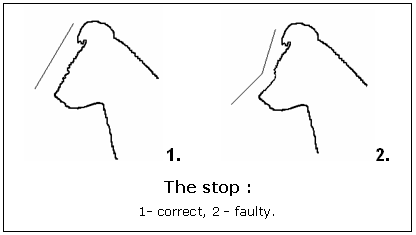
Disqualifying faults:
— round, Puli-like head,
— broad skull top,
— broad and short forehead,
— strong eyebrow arches (owl-faced),
— strong, pronounced stop,
— a nose shorter than 40 % of the head (blunt head).

Jaws/Teeth
The teeth are healthy and well developed.
The Pumi is fundamentally a herding dog, but can also be used for other work (watchdog, or gundog). In any case — being a working dog — he needs a good, solid grab. It is therefore only a natural that the dog needs strong jaws and healthy teeth giving a complete scissor bite.
Eyes
Pumis with almond eyes slightly cut downwards are considered prettier. This type of eye setup makes them look merrier, more cheeky and friendly. The colour of the iris is dark brown, but with lighter coated animals (silver grey and white) a somewhat lighter shaded (lime) iris is also possible.
Faults:
— rounded eyes,
— light brown eyes,
— straight cut eyes,
— eyes placed closer to each other than desired.
Disqualifying faults:
— yellow eyes,
— bluish or greyish eyes,
— glassy eyes (transparent iris).
Ears
The medium-sized upright ears are set on high having a reverse V-shape. The upper end of the upright ears bends forward. The bent part is one-third of the entire ear; sometimes it is only the tip of the ear that bends forth. An ear that expressly and definitely bends forward is considered pretty and desirable.
Although the ears of the Pumi are set on high, they are still not placed on top of the skull but start taking shape behind the cranial region of the skull. The outer ears are very large and strong, using muscle to hold the ears upright.
The ear cartilages of the Pumi do not break across the entire width of the ear, but only bend one-third of the way from the top on the outside of the ear. For this reason the quantity and length of the hair play a major impact on the hearing of the Pumi. The long crown-hair on the ears often tends to draw down the cracked ears giving the impression of the ear being bent too low. The weight of the long and dense crown-hair may draw upright ears down and it may seem that the ears are broken irregularly high.
The ears of the Pumi are in constant motion. They react to all kinds of movement or even the smallest of noises: the ears are swung backwards, forward, or sideways. A perpetually moving sensitive ear is indicative of the exceptionally high level of alertness and vivid temper of the breed. The mood of the Pumi can also be read from the play of the ears.
The regularity of the ear carriage is best assessed when the dog is watching something attentively as they are turned forward in a definite manner. This is not difficult to get with a good tempered Pumi as they tend to listen and pay attention to any interesting sound or movement.
Faults:
— ears bent lower than desired (broken half-ways),
— ears broken too high (only the tip of the ears bends forward),
— ears set on and kept slightly wide.
Disqualifying faults:
— ears pendulous from the base (Puli effect),
— upright ear (Spitz and Mudi effect),
— any combination of unmatched ears.
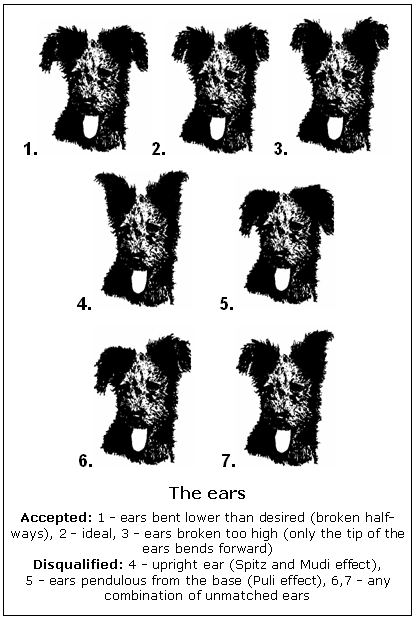
NECK
The neck is set on above the medium, is of suitable length, slightly arched, muscled — what is known as the dry neck. The head on the neck is set on high and is very animated. On animals with short necks head movement is restricted. A Pumi with a neck too long is usually of a loose constitution.
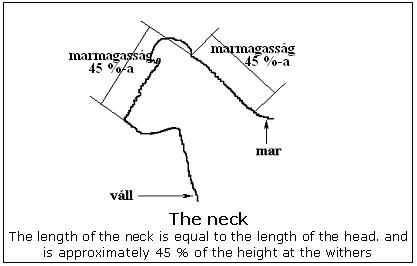
BODY
The length of the body is the same as the height at withers therefore the body of the Pumi is quadratic. The withers are definitely protruding, long and sloping backwards. The blades are steep. The back is short and straight. The croup is short slightly cut off, but suitably broad. The relative proportions of the back: loin: croup is 2 : 1 : 1.
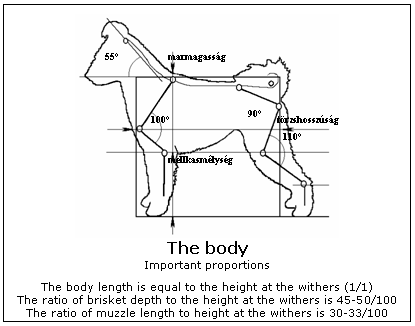
The forechest is not broad but rather deep. Ribs slightly arched, rather flat, running down to the elbow. Belly is tight, tucked upward.
Bone structure is fine and stout. Well developed but not extensive muscles — especially tight and stout. May seem a little long-legged compared to the Puli. A very stout breed.
Faults:
— elongated body (up to 104% of the height at withers),
— extensive, covered muscles,
— shallow brisket,
— barrel-like brisket.
Disqualifying faults:
— elongated body (greater than 104% of the height at withers),
— coarse bones.
TAIL
The tail is set on high, upright and curls forming a circle towards the croup. It is important that the tail be definitely upright and not to lie across the croup. Even if tight, it should still form a small circle with a whole in the middle with a diameter of at least on inch. Crescent-shaped tail carriage is no longer desirable.
It is important that the tail be set on high. A low set tail tends to curl up behind the croup or — in worse cases — hangs downward. Hanging or completely lying tail is inconsistent with the Pumi character just as much as any terrier-like or spiky tail. Uncertain tail carriage is characterised by having the tail hung more often than raised with no particular reason. The tail and tail carriage is an excellent indicator of the Pumi’s temper. A Pumi of the appropriate temper never lets its tail down when in motion or alert; rather he tends to cur it up even tighter. For this reason a tight tail is much less of a fault than, for example, uncertain tail carriage.
This present standard has no requirements concerning the length of the tail. It is not prescribed that the straightened tail should reach to the hock — as it is often the case with other breeds. The Pumi has long upper thighs, a low hock, and hind legs set backwards. It would be unreasonable to impose requirements on the tail of the Pumi that are otherwise imposed on breeds having a much steeper limb position. The Pumi’s tail should be proportionate when curled up: it must not be disturbingly long nor too short — it must not upset the general harmony of the overall impression.
Faults:
— tail set on too low,
— crescent-shaped Mudi tail,
— tail slightly curling to the side,
— tail broken in one or two positions.
Disqualifying faults:
— Puli-like tail lying completely on the back,
— constantly hanging tail,
— spiky, terrier-like tail,
— inherently short tail.
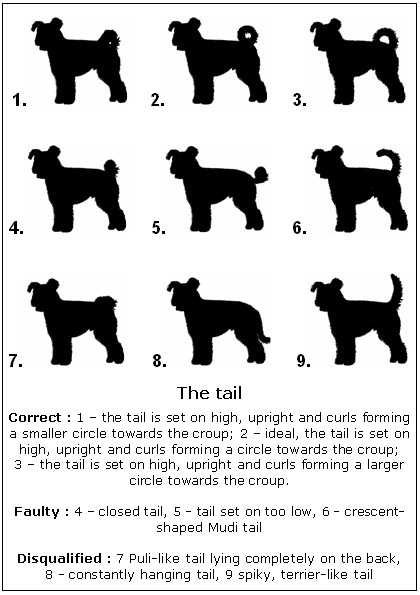
LIMBS
The shoulder blade is long and steep, the upper arm is the same length as the blade. The direction of the blades is defined by the central line. The angle of the shoulder blades is considered suitable when it sets off from the horizontal by app. 55 degrees. The angle formed by the blades and the upper arm should be around 110%. Beside being well muscled, such bone proportions and angulations are typical of terriers and are very close to being «terrier shoulders».
The elbow is formed by the articulation of the upper arm and the forearm. The regular elbow points straight backwards. Elbows stretching outwards are considered serious faults; they are often accompanied by barrel-like brisket and limbs turning inwards. The elbow being near the brisket is coupled with outward bending limbs which prevents the regular and swift movement of the legs.
Only parallel placed forearms render regular limb carriage possible together with regular swift movement of the legs. The forearms are vertical. The metatarsus is always along the same axis with the forearms. The Pumi, similarly to all dogs with a quadratic body, is characterised by a vertical metatarsus.
The forearms are considered regular when viewed from the front they are neither too wide nor too narrow, but straight and parallel. When viewed from the side the forearms are considered regular when the imaginary vertical line stretching from the point of revolution of the blades to the ground goes through the axis of the metatarsus and reaches the ground behind the paw.
Since the metatarsus is steep and the paws are domed and rotund, the toes are tucked up and closely knit (cat feet), the Pumi stands and walks on its toes.
Faults:
— paws turning slightly outward,
— loose paws.
Disqualifying faults:
— bent posture when viewed from the side,
— barrel-like (O — axis of forearms stretching outward, the metatarsus inward) or cow-like
(X — the forearm turns inward and the metatarsus turns outward) stand.
HINDQUARTERS
The hindlegs are the motor driving the dog’s body forth. Being a working dog, the structure and angulation of the hindlegs must be strictly regular.
The upper thighs are muscular, long and set backwards. The stifle is set on the same level as the elbows. The length of the lower thighs is the same as that of the forearms. The hock joint forms a 45 degree angle with the horizontal. A gaunt and clearly outlined hock is desirable. The metatarsus is short, vertical, the hock is steep.
Hindlegs are considered regular if parallel and straight, not too near or far apart when viewed from behind. If an imaginary perpendicular line is drawn from the ischium, it runs in front of the hock and touches the ground in front of the paw. The hind feet are like the forefeet. Dewclaws are not desirable and to be removed.
Faults:
— too narrow or too wide stand on ground,
— slightly outward or inward turning paws,
— dewclaws.
Disqualifying faults:
— strongly outward or inward turning paws,
— sword or chair stand when viewed from the side,
— barrel (O) or cow (X) stand when viewed from behind.
MOVEMENT
The regular and harmonious movement is — just like with most dog breeds — a natural requirement. It is obvious that regular, rhythmical and harmonious gait is only possible to achieve with perfect anatomic built and harmoniously structured limbs.
The steeper shoulder blades together with the relatively longer feet produce a characteristic gait and gallop. Like most quadratic long-legged dogs, the Pumi is also a galloping type dog.
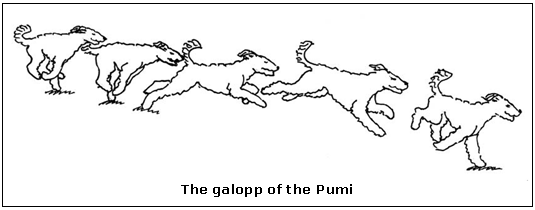
The Pumi’s step is short, energetic with dynamic and cheerful movement.
The bouncy trot of the Pumi is characterised by the complete synchrony of the diagonal limb pairs, a floating phase achieved by putting his hind feet exactly into the foot prints of the forefeet. This is owed to the special body proportions of the Pumi.
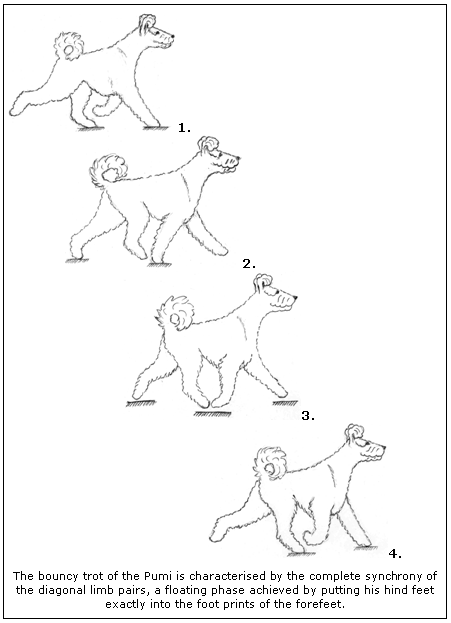
COAT
CHARACTER OF THE COAT
The Pumi has medium long hair. The coat has an average length of 4 to 7 cm, growing to smaller or larger tufts, it is elastic, shaggy, and dense. It consists of a strong, but not coarse, topcoat and a soft undercoat. The topcoat is made up of stronger wiry ornamental (crown) – and general cover — hair whose respective relative ratio is ideally 50-50%. The undercoat is fine containing no marrow. The hair in the topcoat is longer containing marrow. The shaggy nature of the hair has also been recorded in Csaba Anghi’s scientific description of the Pumi. The term «villous» means shaggy unmatted hairs. Hair is considered flexible when it regains its original shape and position after being stroked.
The Pumi’s coat contains relatively much ornamental hair. The quality of the coat is defined by the thickness of the ornamental hairs and the thinner general cover hairs, their respective ratio, and length. The wiry and flexible ornamental hairs are stronger and somewhat longer than the general cover hairs. The best expression to describe good quality Pumi coat would perhaps be coarse; not harsh, not spiky, but certainly not soft, fine or woolly.
The rate of good quality ornamental curly hairs against general cover hairs is app. 50—50%. The tufts are twirled like a corkscrew and tapered towards the end therefore they conduct water really well and dry fats. This type of coat requires no regular care it does not get matted. It is elegant and attractive.
When the rate of the curly hairs falls against the finer cover hair, the coat of the Pumi becomes more woolly requiring more frequent grooming ad care. This type of coat is very attractive when cared for, but is prone to get matted and tangled when uncared for.
The rate of undercoat in wavy hair is lower than in curly coat. The ornamental hairs are stronger and higher in number than general cover hairs. The tufts are wider and wavy. This type of hair is not prone to matting and requires no frequent grooming or care. It is less attractive but accepted.
An extreme form of the wavy coat is when the tufts are short or have very strong ornamental hair and very little general cover hair and undercoat. This is called «sinka» meaning plain. It requires minimum care and grooming. This condition is often accompanied by upright ears more lightly coated head and limbs. Thinning, non attractive hair — no longer desirable.
COAT COLOUR
With the Pumi, the opportunity is still open to cross breed dogs of various colours. The dominance of colours is well known hence the colour of the puppies to be born can be predicted with relatively good accuracy.
Although real black is possible, but very rare among Pumis. The most common colour is the shades of grey. The vast majority of puppies born black lose the colour of their coat and they turn grey in a process similar to that of the silver poodle. Greying begins a few weeks after birth, first around the eyes, the cheeks, the limbs, then continues all throughout the body. They get their final colour around the age of one. The grey colour palette is extremely rich, from dark grey going to very light all shades are allowed as long as the colour is intense without any distinctly different colour markings.
A fawn Pumi having a black mask is very rare. The term «masked fawn» as adopted from Puli owners is incorrect. It would be more appropriate to call this colour shaded fawn or gold-sable after the English term. The dominant yellow gene (Ay) of the agouti allele is responsible for the red or yellow hair colours. The colour may be yellow, red, cream-coloured but always shaded with various quantities of black-, dark grey-, or silver-grey-tipped hairs. The extent of shading of the basic yellow always varies mainly on the head, the ears, the shoulders, along the spine, and the tail, but may be larger in extent: going down on both sides of the body. The basic reddish, greyish, creamy colour may fade as the dog gets older.
With white Pumis, the desired colour should be white as snow, free from yellowish shades, with black nose and slate-grey pigmentation.
SIZE AND WEIGHT

© 1995-2008 Tamara Länger